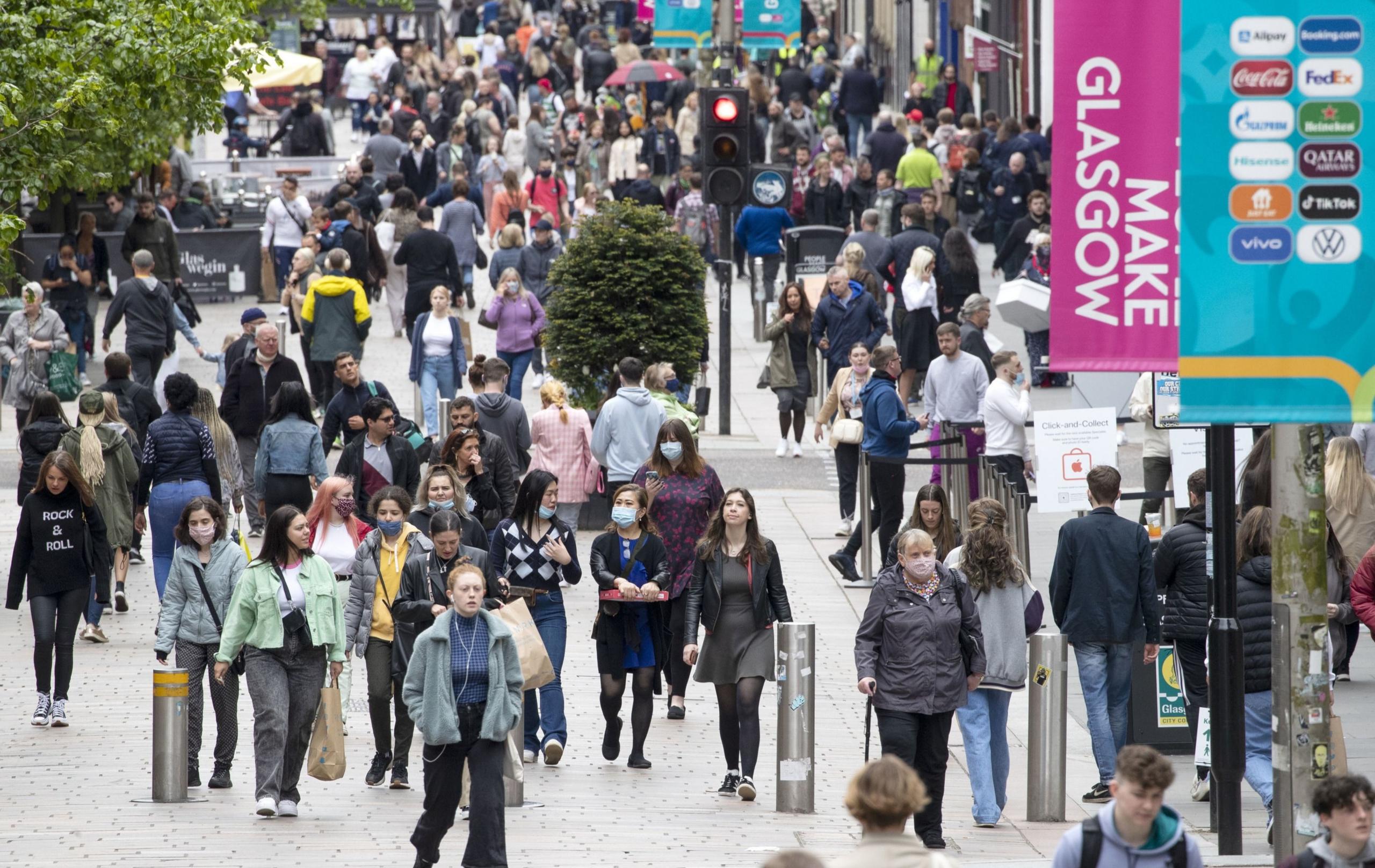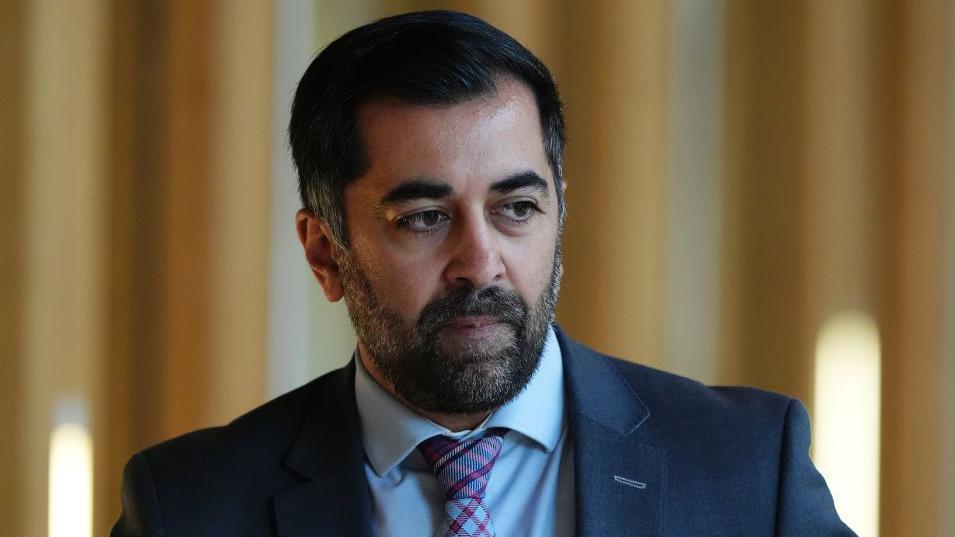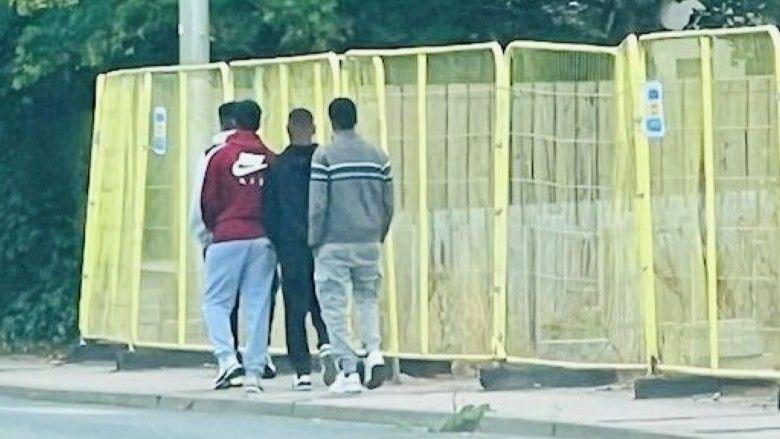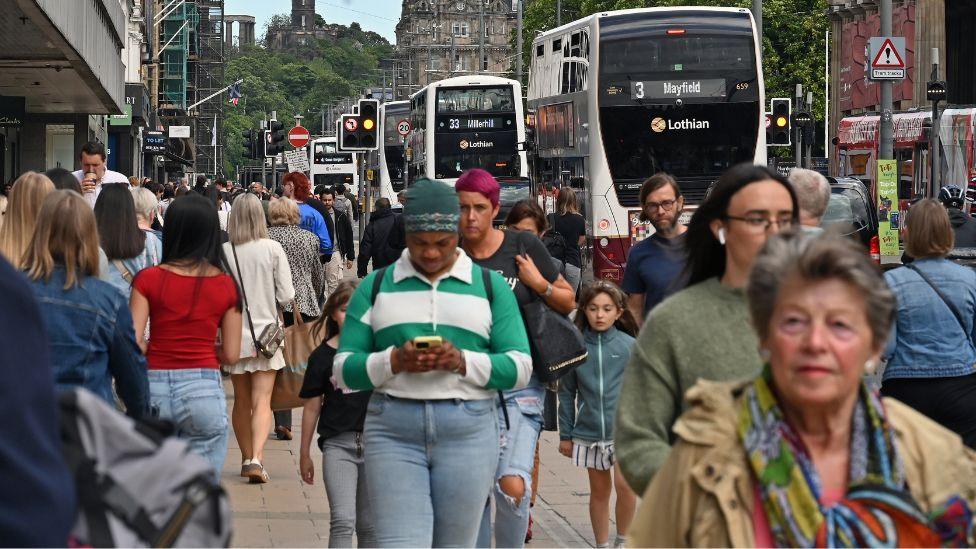Scotland's deaths outnumber births - so why is the population still rising?

- Published
A record number of people are living in Scotland, topping 5.5m for the first time in 2023.
But deaths have outnumbered births for the last decade, so why is the population still rising?
The simple answer is more people are moving to Scotland than leaving, and most of the arrivals are coming from overseas.
Scottish ministers say the country's population growth depends on this positive net migration, however, it is not without its controversy.
Back door routes to the UK, such as people arriving on small boats, continue to hit the headlines.
But it is front door routes, like international student visas, which account for most of Scotland's recent immigration boom.
Is immigration rising in Scotland?
People leaving to build a new life elsewhere was the dominant migration story of Scotland's past, but not anymore.
Immigration has been adding to the country's population for the last 24 years.
This means every year more people have moved to Scotland than left, with noticeable spikes at key moments, such as eight Eastern European countries joining the EU in 2004 and Brexit in 2020.
However, the biggest increases have come more recently.
A total of 68,200 people moved away from Scotland in the year to mid-2024, while 124,600 arrived.
The difference between the two - known as net migration - is 56,400.
And, of the total, three quarters came from overseas.
National Records of Scotland (NRS) analysis, external suggests international immigration "remains historically high".
Separate snapshot population data, external reinforces the point.
Scotland's population grew by 144,400 (2.7%) between the 2011 and 2022 censuses.
In this period, the number of people living in Scotland who were born in the country decreased by 90,400.
This decrease was offset by increases in those born in the rest of the UK (up 49,200) and overseas (up 185,600).
At the same time, there have been more deaths than births each year since 2015.
The NRS call the difference between the two "the natural change" and they predict it will continue to widen for the next two decades as people have fewer children and the older population grows.
NRS projections suggest inward migration will continue to plug this natural change gap and Scotland's population could be as high as 5.8m by 2047.
A total of 23 council areas are expected to see population growth in the next decade.
But a further nine areas will experience decline by mid-2032 if current demographic trends, like falling birth rates, continue.
Equalities Minister Kaukab Stewart has said the figures show that Scotland's population growth depends on positive net migration with migrant workers filling critical skills gaps in sectors such as healthcare and agriculture.
What is driving the increase in immigration?

One of the main drivers of immigration to Scotland in recent years has been the arrival of more international students and their dependents.
In 2022/23 an all-time high of 83,975 people from outside of the UK were studying in the country.
But the number of EU students in Scotland has fallen by half, down to just 10,430, since Brexit
The share of foreign students had been rising from one in 20 in the 1990s to more than one in four.
This followed post-Brexit reforms made by Boris Johnson's government which made it easier for non-EU nationals and their families to get visas.
China remains the biggest supplier of international students to Scotland with 17,565 enrolments last year, up from 14,275 in 2019/20.
It is a huge money spinner for universities because they charge international students higher fees.
Trade body Universities Scotland has estimated the presence of international students contributed between £4 and 6bn to Scotland's economy since 2019., external
But the number of overseas students at Scottish universities dropped by more than 10,000 last year and this has left some institutions reliant on them, such as Dundee University, with huge financial problems.
People also arrive in Scotland on pre-arranged visas to work and this can range from international footballers to agriculture and care home workers.
It is not clear how many people, and their dependents, arrive in Scotland on these skilled worker visas every year.
However, the number of health and care-related visas issued in recent years trebled at a UK level, external to plug staffing gaps, before a tightening of the rules.
And what is not captured in any of the data is the number of unauthorised migrants living here, such as people who overstay holiday visas or rejected asylum applicants who do not leave.
The UK government has not attempted to estimate this tally for more than 20 years.
But what about refugees and asylum seekers?
People seeking refugee or asylum status in the UK also come to Scotland but the numbers are small, accounting for 0.67% of the total population.
Home Office data up to up to June, external shows 28,934 Ukrainians have moved to the country under a resettlement scheme since the Russian invasion of Ukraine.
In addition, a total 1,875 people are living in Scotland under the Afghan resettlement programme.
But it is the number of asylum seekers housed in the country which has drawn the most attention in recent months.

Protesters outside a hotel housing asylum seekers in Perth earlier this summer
There are a total of 6,107 asylum seekers in Scotland, a figure that has been steadily rising in recent years in line with the record numbers of applications across the UK.
Scotland houses nearly twice as many asylum seekers as Wales, but 3,579 less than the Yorkshire and Humber area of England, which has a comparable-sized population to Scotland.
There are 94,817 asylum seekers living across England.
Which parts of Scotland have the most migrants?
More people moved in than moved out in every council area of Scotland last year, according to NRS data.
The biggest jump in net migration was in Glasgow, which grew by 1.8% (11,540 people) compared to mid-2023, followed by Midlothian at 1.5% (1,510 people) and Edinburgh 1.2% (6,540 people).
NRS analysis , externalshows that by mid-2032, 23 out of the 32 council areas in Scotland will see their population rise, with a near 10% rise expected in Edinburgh and 14.7% in Midlothian.
The remaining areas, including West Dunbartonshire and Inverclyde, are expected to see a fall in the number of people living there.
Ross Bond, a senior lecturer in sociology at the University of Edinburgh, has produced an analysis of the 2022 Census , externalwhich shows that one in ten respondents were born outside of the UK, up from 3.8% in the 2001 census.
The majority of people arriving from overseas are under the age of 25 and many are concentrated in cities, his study shows.
Mr Bond points out the council wards in Glasgow and Edinburgh where China provides the highest number of migrants of any single country is likely a result of large numbers of international students, similarly with the high number of Americans in St Andrews.
Elsewhere, Home Office data shows the areas with the largest numbers of asylum seekers staying in hotels are Aberdeen City (364), Aberdeenshire (312), Perth and Kinross (192) and City of Edinburgh (162).
Glasgow is hosting by far the biggest number of asylum seekers (3,844) with the majority living in long-term accommodation, which the local council says is costing them around £66m in extra housing costs every year.
- Published19 September

- Published11 September

- Published14 August
